Censured music from the Baroque (aka: It's the little things)
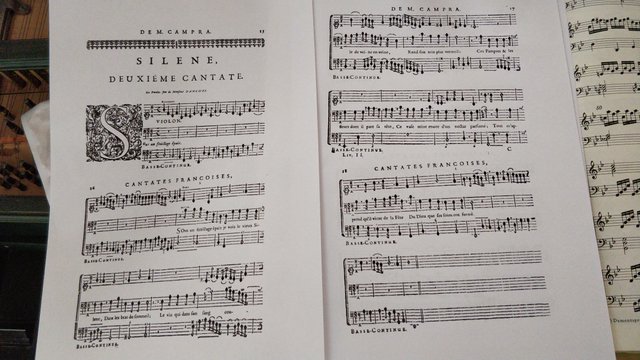
This weekend, I had a nice little concert with @musicapoetica at the National Theatre in The Hauge. It was a bit of an interesting concert, as the backbone pieces of the concert were two cantatas that were reconstructed from a Baroque Opera (Les Amours de Vénus, 1712) by Andre Campra that was banned by the Sun King, Louis XIV. The original comic opera was banned after several performances as it was seen to be promoting the twin dissident views of female promiscuity and the neglect of the governing authority.
The story revolves around Venus, and her lack of faithfulness to Vulcan. When Vulcan complains to Jupiter, the God of Gods essentially declines to punish Venus and refrains from interacting with his pantheon. At the time, Louis XIV was seen to be retreating into the the religious influences of Madame de Maintenon, and this opera was seen to be a comment on his lack of concern for his empire and subjects. It was also seen to be at odds with the Catholic ideas of marital (read: female) faithfulness, as the wandering goddess is left unpunished (an amusing double standard, as the male roles of the time were generally allowed to get around quite a bit!).
However, Baroque composers were ever resourceful, never letting compositions go to waste. Campra recast some of the arias with new text into two cantatas, of which one required a violin (the other I wasn't playing in!). Basically, it is a story of a drunkard who is set upon by Silene (a companion of the god of wine, Dionysus) and Bacchus (Dionysus... there is a bit of pantheon mixing?). It does make for some very interesting writing in the music, as Campra tries to portray the drunken concept across in music!

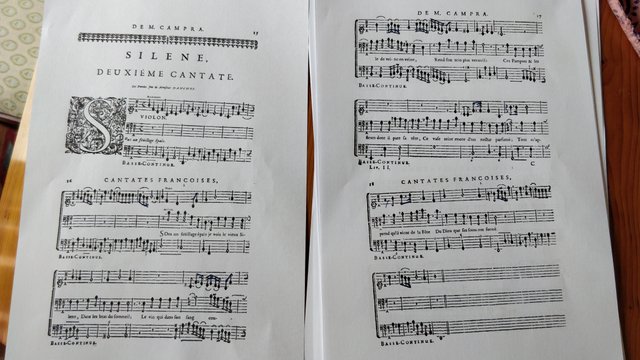
Anyway, the manuscripts are from a time when they utilised a method known as block printing... where each note (length and position on the stave) were actually individual blocks... where were all fitted together on a plate before printing. This means that all the notes are not joined up like on a modern piece of music (or even modern Classical music editions) but each are seperated. It's an older form of printing which was superceded by the Amsterdam printing methods that appeared in the 18th century.
However, for me... it is a form of printing that I find especially difficult to read. When I read music, I can see patterns ahead which makes it much easier to read music... when I essentially am reading several blocks of notes in advance. With this sort of single block printing, my brain gets tricked into reading each single note individually. Needless to say, this is a huge loss in efficiency... and when combined with the French Violin Clef (G is the lowest line on the stave, instead of the second line from the bottom), it severely reduces my ability to read ahead and be reactive in performance... as so much concentration is being spent in reading the notes... it's not a disaster, but it is the difference between feeling completely "in the zone" and batting off and endless sequence of notes in real time.
It's funny, I read all sorts of ancient clefs and terrible printing styles and handwriting from original sources, playing on a wide variety of violins, violas, viola dámore in different tunings... but time after time, this block printing is the one that trips me up and grinds me to a halt!
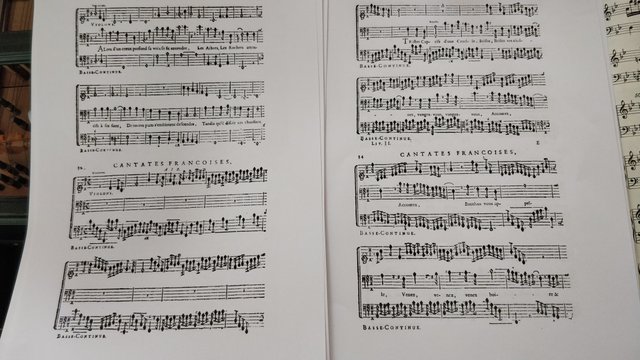
So, a small fix... just joining the barring of the notes with a pen makes a world of difference! My brain finally lets go of notes, and can go back to reading several bars ahead. I'm free again to interact in real time to all the unexpected nuances that make up a real live musical performance!

It really is strange how the brain works... one very minor change in perception, and the brain behaves completely differently!
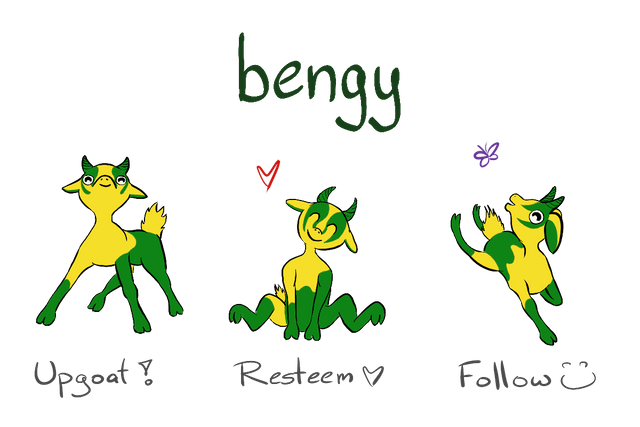
Account banner by jimramones
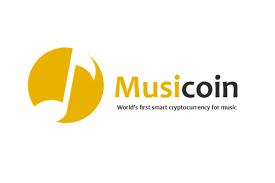
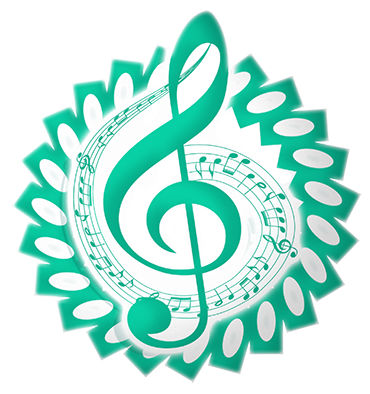


.gif)
Very interesting post today @bengy. To think segments of music are deconstructed and utilized in other"less controversial" pieces is quite humorous. Amazing that certain forms of improper behavior were deemed allowable and thus openly displayed through music. Great history. You are quite a genius, I hope you realize that! Enjoy reading your posts :)
Thanks! Glad you enjoyed the post... during the Baroque time, ti was quite common to "repackage" music and reuse it in a completely different setting and form.. in fact, some famous composers even repackaged (aka plagarised) music from lesser known composers!
Anyway... things that we know a lot (due to it being the area of our specialisation) about tend to sound more impressive to a lay person! There are many things that I read about here on Steem and elsewhere that are completely mind-blowing for me... but are probably pretty mundane for the writer!
Your post has been supported and upvoted from the Classical Music community on Steemit as it appears to be of interest to our community. We also support jazz and folk music posts!
If you enjoy our support of the #classical-music community, please consider a small upvote to help grow the support account!
You can find details about us below.
The classical music community at #classical-music and Discord. Follow our community accounts @classical-music and @classical-radio or follow our curation trail (classical-radio) at SteemAuto!
Delegation links: 10SP, 25SP, 50SP, 75SP, 100SP, 150SP, 200SP, 250SP, 500SP, 1000SP
This is fascinating. External representations really do affect cognitive ease. Of course, it matters that you are used to the newer form of printing music. However, its clear that representations are often the most powerful tools that we have for advancing human capability. Mathematical notation and graphs were and are crucial for much of our advances.
Oddly enough, the "newer" form of music print that I'm used is not the modern prints... but ones from 300 years ago, which most modern musicians can't read...
... but agreed, data representation is such a big field... the way the data is presented can definitely give new insights or angles into what is essentially exactly the same raw data.
Hey @bengy
Other than having a serviceable voice for the shower, I am music illiterate! I have never read music although both my wife and daughter can. My wife is a level 7 (I think that's right, either way it's a high level) clarinet player and plays the Sax and piano.
It is weird how the brain pieces together information. There is a funny thing where a piece of writing has all the letters in each word jumbled up apart from the first and last. I can read it like it was absolutely normal. Lol. I'm assuming everyone else can too!
Cheers.
Gaz
Posted using Partiko Android
It's crazy how the brain works like that... I have no trouble when the jumbling is in English... but if it is Dutch, then I'm lost... even if a word is mis-spelled I go crazy!
How fascinating! I'm late with my comment, as I've been away again, and returned to a pile of things to do. But I must look this one up and give it a listen. I love the inventiveness of the composer and his desire to poke fun at authority.
Yes... especially given that it was a much more dangerous thing to do back then!
Congratulations! This post has been upvoted from the communal account, @minnowsupport, by Bengy (also musicapoetica) from the Minnow Support Project. It's a witness project run by aggroed, ausbitbank, teamsteem, someguy123, neoxian, followbtcnews, and netuoso. The goal is to help Steemit grow by supporting Minnows. Please find us at the Peace, Abundance, and Liberty Network (PALnet) Discord Channel. It's a completely public and open space to all members of the Steemit community who voluntarily choose to be there.
If you would like to delegate to the Minnow Support Project you can do so by clicking on the following links: 50SP, 100SP, 250SP, 500SP, 1000SP, 5000SP.
Be sure to leave at least 50SP undelegated on your account.
This post has received a 3.13 % upvote from @drotto thanks to: @sbi-booster.
Thank you bengy! You've just received an upvote of 29% by artturtle!
Learn how I will upvote each and every one of your posts
Please come visit me to see my daily report detailing my current upvote power and how much I'm currently upvoting.
Congratulations @bengy! You have completed the following achievement on the Steem blockchain and have been rewarded with new badge(s) :
You can view your badges on your Steem Board and compare to others on the Steem Ranking
If you no longer want to receive notifications, reply to this comment with the word
STOPTo support your work, I also upvoted your post!
Do not miss the last post from @steemitboard:
Vote for @Steemitboard as a witness to get one more award and increased upvotes!
You got a 8.73% upvote from @ocdb courtesy of @bengy! :)
@ocdb is a non-profit bidbot for whitelisted Steemians, current max bid is 20 SBD and the equivalent amount in STEEM.
Check our website https://thegoodwhales.io/ for the whitelist, queue and delegation info. Join our Discord channel for more information.
If you like what @ocd does, consider voting for ocd-witness through SteemConnect or on the Steemit Witnesses page. :)